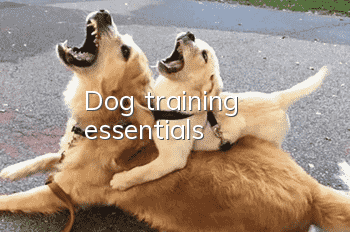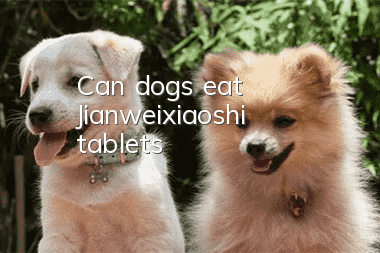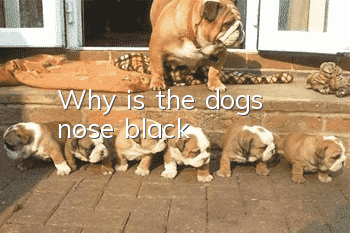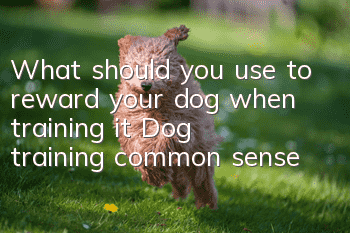Dog training essentials

If your dog is well trained, it will make getting along with your dog more enjoyable, and this training will not affect its basic characteristics. A happy relationship based on mutual love, trust, and respect will last for a long time.
Training your puppy early in his life can lay the foundation for a happy life later on. You should spend some time during this critical period of puppy socialization to help your puppy become familiar with its surroundings and get along well with other people and dogs. There are some basic commands you should teach your puppy. First, it should be trained to respond to its own name (preferably consisting of two catchy words), and secondly, it should be able to understand the following commands:
--"come" and "sit"
--"Stop" (standby)
-- Walking with a dog
--"Get down"
Before you start training, you should first make sure that your dog can understand your own name. This will build trust between you and your dog. All members of the family should participate in this training program. Note that your commands must be consistent during training. You should clearly give these commands to your dog, and at the same time, gently repeat them to him or her, for example, when making him sit, give him the command while gently pressing his buttocks to make him sit. Your puppy will soon understand what you mean. If it disobeys the command, you can withdraw its reward, but you cannot punish it. Otherwise, it will think that command means punishment. And if your dog is afraid of you, training won't pay off well.
Training should pay attention to the following points:
Start training your puppy as early as possible, because if it has developed some bad habits, it will be difficult to correct them.
Do the exercises one at a time, in the correct order.
You should train your dog not to jump out when the car door opens. At this time, you can use the "stop" command.
Keep your voice happy and firm through all stages of training. Different commands use different tones.
When giving a command, keep it consistent and use the same tone of voice.
You must reward the dog for its success and remove the reward if it fails. The dog should be kept in a happy mood, so the dog should be given some play time between training sessions.
After this, you may want to enroll your dog in a training class to improve their training. The experienced trainers there will help you overcome some training difficulties. This kind of training class is fun and provides your dog with some opportunities to socialize with other dogs.
Training indoor living habits for dogs
Puppies are naturally clean and want to please their owners. Therefore, dogs that grow up normally should be trained on indoor living habits.Practicing is not very difficult. Puppies should be trained on their excretion habits as soon as they are brought into the home (usually when they are 6-8 weeks old), otherwise it will be difficult to train them in this area in the future. We need to have patience and perseverance when training.
Since puppies have small bladder and intestinal capacities, they need to eliminate frequently. If you have an enclosed garden, take your puppy out when it's time to eliminate and place it in a suitable area. In addition, when you get up every morning, every night before going to bed, and after every meal, the puppy should be led to the same place outdoors to urinate. You should go with your puppy and stay with him while he eliminates, and praise him after he eliminates.
Sometimes you may not have time to take your puppy out to the garden, so spread some newspapers indoors where your puppy is active, preferably near the door. When the puppy needs to excrete, put it on the newspaper, so that the puppy will associate excretion with the newspaper. Gradually reduce the amount of newspaper spread until the puppy no longer needs newspaper. You should also cover your puppy with newspaper at night, as it is impossible for your puppy to go all night without peeing. If you don't have a garden, you should train your puppy to eliminate on newspaper until they are vaccinated and can play outside.
If your puppy poops where it shouldn't, don't scold it unless it's caught red-handed. If your puppy makes a mess when excreting, be sure not to press its nose into the excrement, as this will cause it to panic and fear. You should clean up the mess and then spray some deodorant on it. This will stop your puppy from using this area to eliminate.
Take care of your puppies carefully when taking them out. You should learn to recognize when your puppy needs to eliminate. Some dogs will circle in circles when they want to eliminate, others will sniff the ground. When they excrete, you can say words such as "Hurry up" and "Keep it clean" to train them to excrete according to the command. Your commands should use the same words and maintain the same tone of voice, otherwise, the dog will become confused.
If your dog is older and not well trained, you can use the same method. But older dogs don’t learn as quickly as puppies.
Notes on excretion habit training:
Dog owners have the obligation to prevent puppies from excreting randomly, and if puppies urinate in public places, they should clean it up. There are some small shovels for removing poop (e.g., Aisba shovel) available in stores
The dog should be trained on its elimination habits as soon as it arrives at your home, and should continue until the training is successful (approximately when it is 12 weeks to 6 months old).
Try to get your dog to eliminate regularly and plan his diet and exercise accordingly.
Train your dog to eliminate on command (to a certain extent).
"Recall" and "Sit" training
If you are using food as a training tool, divide your dog's meals into portions. When each meal is served, have an assistant hold the puppy from a short distance away. You then hold out the food bowl and call the puppy's name accompanied by the "come" command. After giving the command, the person holding the puppy should release it immediately.
When the dog approaches the food bowl, take a step or two back and encourage him to follow. Hold the bowl above the dog's head, call its name, and give the "sit" command at the same time. If necessary, use your other hand to assist in this action. Praise your dog when he sits down toward you, then put the bowl on the ground and let him eat. Repeat this training after 10-15 minutes and feed it another portion of food.
This training should be done step by step, with the assistant gradually moving the dog further away until it is out of sight.
After the above training is completed, you can ask your assistant to distract the dog when you call it.
When your dog hears a call and can run to you for food without being disturbed, you can take the dog outside for training.
For safety reasons, put a 15-meter-long rope around the dog's neck so that the dog can be caught back if it runs away. Now you can do the recall exercise from scratch. Once you are certain that your dog can perform the "come" and "sit" commands without interruption, it is time to remove his leash.
- How much does a purebred thin dog cost? Check out the market price of thin dogs!
- At what age can a female puppy be neutered?
- How to choose a Border Collie puppy? What are your tips for choosing a Border Collie?
- What is the misunderstanding about the 24-hour rabies vaccine? What about the rabies vaccine!
- Things to note when raising dogs outdoors
- Confused about your dog’s physiological stages? Just read this article!
- How should a puppy’s dog food be soaked? How old should a puppy be before it has to eat soaked dog food?
- Hair care tools and care methods for short-haired dogs
- Can a dog get an injection if he has a cold in two months?
- Is King Charles Spaniel easy to raise? How much does it cost? Does it shed hair?



